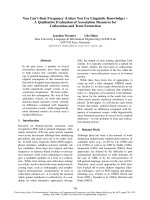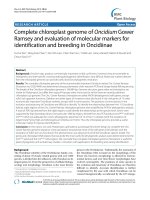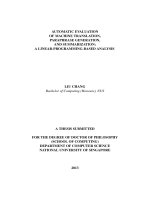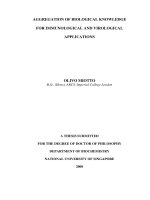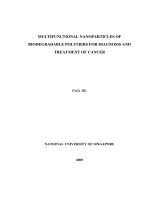Evaluation of chilli genotypes for growth and fruit yield attributing traits under chhattisgarh plain conditions - Trường Đại học Công nghiệp Thực phẩm Tp. Hồ Chí Minh
Bạn đang xem bản rút gọn của tài liệu. Xem và tải ngay bản đầy đủ của tài liệu tại đây (264.31 KB, 6 trang )
<span class='text_page_counter'>(1)</span><div class='page_container' data-page=1>
<i><b>Int.J.Curr.Microbiol.App.Sci </b></i><b>(2017)</b><i><b> 6</b></i><b>(11): 3478-3483 </b>
3478
<b>Original Research Article </b>
<b>Evaluation of Chilli Genotypes for Growth and Fruit Yield Attributing </b>
<b>Traits under Chhattisgarh Plain Conditions </b>
<b>Versha Kumari*, J. Singh, D. Sharma and Sunidhi Mishra </b>
Department of Vegetable Science, Indira Gandhi Krishi Vishwavidyalaya,
Raipur, (C.G) – 492012, India
<i>*Corresponding author </i>
<i><b> </b></i> <i><b> </b></i><b>A B S T R A C T </b>
<i><b> </b></i>
<b>Introduction </b>
Chilli is the most economic and popular
additive to improve food acceptability. It is
grown for use as a vegetable (green chilli) and
spice (dry chilli) under tropical, subtropical
and temperate climates. The presence of
capsaicin in chilli is responsible for its
pungency and it has medicinal value as well.
It also contains vitamin A (292.04 IU),
vitamin C (143.7 µg), vitamin K (14 µg),
vitamin E (0.69 mg), and other minerals. A
wealth of information and scientific evidences
are rapidly accumulating on the beneficial
effects of wide variety of food components on
human health. The most important vitamin in
fruits and vegetables is vitamin C. Chilli is
quite high in other nutritive value containing
moisture (87.7 g), protein (2.9 g),
carbohydrate (3.0 g), fiber (6.8 g), it has
covered a vast agricultural area throughout
the country and contributes an important
share in Indian table food. Although the crop
is available throughout the year, the demand
of chilli is further increasing with the
expanding population. A wide range of
<i>International Journal of Current Microbiology and Applied Sciences </i>
<i><b>ISSN: 2319-7706 Volume 6 Number 11 (2017) pp. 3478-3483 </b></i>
Journal homepage:
In order to evaluate the performance of sixteen genotypes of Chilli for fruit yield and its
component traits, the present experiment was laid under randomized complete block
design with three replications at Indira Gandhi Krishi Vishwavidayalaya (IGKV), Raipur
during <i>rabi </i>season of 2016-17. Analysis of variance revealed that the genotypes differed
significantly for all the characters namely, days to first flowering, days to 50 % flowering,
plant height (cm), number of primary branches, stem girth (cm), days to first picking, fruit
length (cm), fruit girth (cm), stalk length (cm), number of seeds per fruit, number of fruits
per plant, fresh weight of fruits (gm), dry weight of fruits (gm), dry matter % of fruits, fruit
yield per plant (gm), fruit yield per plot (kg), fruit yield per ha (q) indicating the existence
of the enough amount of variability in the material studied. Mean performance of all the
genotype for different characters was studied and the genotype namely, 2014/CHIVAR-9
was found to give highest total fruit yield plot-1. Fruit yield per plot ranged from 8 kg to
19.52 kg with an overall mean of 14.03 kg. The highest total fruit yield was recorded in
genotype 2014/CHIVAR-9, which was statistically <i>at par</i> with the performance of
Kashi Anmol-2 (18.50 Kg), 2014/CHIVAR-7(17.83 kg), 2014/CHIVAR-10 (16.99 kg) and
2016/CHIVAR-6 (15.9 kg). Genotype 2016/CHIVAR-5 (8 kg) was yielded minimum
fruit yield per plot.
<b>K e y w o r d s </b>
Chilli, ANOVA, Mean
performance, Fruit
yield.
<i><b>Accepted: </b></i>
26 September 2017
</div>
<span class='text_page_counter'>(2)</span><div class='page_container' data-page=2>
<i><b>Int.J.Curr.Microbiol.App.Sci </b></i><b>(2017)</b><i><b> 6</b></i><b>(11): 3478-3483 </b>
3479
variability reportedly exists in this crop.
Therefore, the present study was aimed at
comparison of different chilli genotypes to
identify and select the most appropriate one
with enhanced potential for growth and yield
in Chhattisgarh plain conditions.
<b>Materials and Methods</b>
The present experiment was conducted at
Indira Gandhi Krishi Viswavidayalaya
(IGKV), Raipur during <i>rabi</i> season of
2016-17 in order to evaluate the performance of
sixteen genotypes of chilli for various yield
and its component traits under field condition
with three replications of each genotype. Each
plot measuring 4.2 x 3.5 m2 had six rows
spaced at 60 cm apart with intra-row spacing
of 50 cm. The chilli seeds were planted during
second week of September, 2016. The
recommended dose of fertilizer <i>i.e.</i> nitrogen
150 Kg, phosphorus 75 Kg and potassium 60
Kg per hectare was applied. Half nitrogen was
applied at the time of planting and remaining
was applied in two splits <i>i.e., </i>at 30 and 60
DAP. Crop was visited regularly throughout
the growing season and intercultural
operations such as weeding, irrigation and
plant protection measures were performed as
and when necessary. The study on analysis of
variance and mean performance of genotypes
was carried out for different growth and yield
parameters.
<b>Results and Discussion </b>
<b>Analysis of variance</b>
Analysis of variance revealed that mean sum
of squares due to genotypes was found to be
highly significant (at 1% level of
significance) for Days to first flowering, Days
to 50 % flowering, Plant height (cm), Number
of primary branches, Stem girth (cm), Days to
first picking, Fruit length (cm), Fruit girth
(cm), Stalk length (cm), Number of seeds per
fruit, Number of fruits per plant, Fresh weight
of fruits (gm), Dry weight of fruits (gm), Dry
matter % of fruits, Fruit yield per plant (gm),
Fruit yield per plot (Kg), Fruit yield per ha
(q). This suggested the presence of substantial
amount of genetic variation among the
genotypes that could be exploited in selection
for desirable traits. All the above findings are
in close agreement with the findings of Sahu
<i>et al., </i>(2016) for total fruit yield and number
of shoots; Janaki <i>et al., </i>(2016) and Patel <i>et al., </i>
(2014) who reported variability for flowering,
fruit size, number of fruit per plant, fruit
weight and yield/plant. The result of analysis
of variance for all the characters under study
is presented in Table 1.
<b>Mean </b> <b>performance </b> <b>of </b> <b>genotype </b> <b>for </b>
<b>different characters </b>
Mean performance of genotypes for various
growth and yield attributing traits is presented
in Table 2 and the results are explained
below:
<b>Plant height (cm) </b>
Plant height ranged from 33.37 to 66.50 cm
with an overall mean of 55.01 cm. Genotype
2014/CHIVAR-4 was recorded for maximum
plant height and lowest plant height was
recorded in Kashi Anmol - 2.
<b>Stem girth (cm) </b>
Stem girth ranged from 3.41 cm to 4.88 cm
with an overall mean of 4.11cm. Genotype
2012/CHIVAR-8 was recorded with
maximum stem girth and lowest stem girth
was recorded in 2016/CHIVAR-3.
<b>Number of primary branches per plant </b>
</div>
<span class='text_page_counter'>(3)</span><div class='page_container' data-page=3>
<i><b>Int.J.Curr.Microbiol.App.Sci </b></i><b>(2017)</b><i><b> 6</b></i><b>(11): 3478-3483 </b>
3480
with maximum number of primary branches
and lowest Number of primary branches was
recorded in 2016/CHIVAR-3.
<b>Days to first flowering </b>
The first flowering date ranged from 35 days
to 58.67 days with an overall mean of 47.29
days.
Earliest flowering was recorded in
2016/CHIVAR-4 and delayed flowering was
recorded in 2014/CHIVAR-2.
<b>Days to 50% flowering </b>
Days to 50% flowering ranged from 43.67
days to 69.30 days with an overall mean of
59.65 days. Earliest 50% flowering was
recorded in 2016/CHIVAR-4) and delayed
50% flowering was recorded in
2016/CHIVAR-2.
<b>Days to first picking</b>
Days taken to first green fruit picking ranged
from 91 days to 103.11 days with an overall
mean of 99.48 days. Earliest harvest was
recorded in the genotype 2016/CHIVAR-5
whereas, maximum days to first fruit picking
was recorded in the genotype
2014/CHIVAR-2.
<b>Fruit length (cm) </b>
Length of fruit ranged from 8.09 cm to 13.84
cm with an overall mean of 8.99 cm.
Genotype 2014/CHIVAR-9 was recorded for
maximum fruit length lowest fruit length was
recorded in genotype 2016/CHIVAR-5
<b>Table.1 </b>Analysis of variance for fruit yields and its component
<b>S. No. </b> <b>Characters </b>
<b>Mean Sum of Square </b>
<b>Replication </b> <b>Treatments </b> <b>Error </b>
<b>Degree of freedom </b>
<b>2 </b> <b>15 </b> <b>30 </b>
1 Days to first flowering 39.400 142.440** 21.550
2 Days to 50 % flowering 14.330 215.890** 13.870
3 Plant height (cm) 21.590 261.710** 10.350
4 Number of primary branches 0.410 17.630** 0.570
5 Stem girth (cm) 0.090 0.640** 0.050
6 Days to first picking 0.271 52.176** 3.760
7 Fruit length (cm) 0.100 7.960** 0.253
8 Fruit girth (cm) 0.036 4.333** 0.012
9 Stalk length (cm) 0.054 0.599** 0.084
10 Number of seeds per fruit 59.391 478.556** 22.766
11 Number of fruits per plant 47.206 1285.059** 360.741
12 Fresh weight of fruits (gm) 22.602 295.842** 9.451
13 Dry weight of fruits (gm) 0.083 18.565** 0.424
14 Number of pickings 0.583 0.617 0.317
15 Dry matter % of fruits 9.440 117.407** 3.397
16 Fruit yield per plant (gm) 337.133 12928.090** 870.557
17 Fruit yield per plot (Kg) 2.838 33.389** 2.757
18 Fruit yield per ha (q) 129.553 1543.586** 127.934
</div>
<span class='text_page_counter'>(4)</span><div class='page_container' data-page=4>
<i><b>Int.J.Curr.Microbiol.App.Sci </b></i><b>(2017)</b><i><b> 6</b></i><b>(11): 3478-3483 </b>
3481
<b>Table.2 </b>Mean performance for fruit yield and its components in chilli
<b>Genotypes </b>
<b>Characters </b>
<b>1 </b> <b>2 </b> <b>3 </b> <b>4 </b> <b>5 </b> <b>6 </b> <b>7 </b> <b>8 </b> <b>9 </b> <b>10 </b> <b>11 </b> <b>12 </b> <b>13 </b> <b>14 </b> <b>15 </b> <b>16 </b> <b>17 </b> <b>18 </b>
<b>2016/CHIVAR-3 </b> 43.33 60.33 49.78 2.93 3.41 102.67 8.43 3.31 3.45 58.20 111.07 15.17 2.43 5.67 16.80 292.30 12.37 84.14
<b>2016/CHIVAR-4 </b> 35.00 43.67 66.50 9.73 3.45 91.33 8.29 3.35 3.25 70.53 106.47 14.02 3.47 5.36 24.73 271.40 11.29 76.77
<b>2016/CHIVAR-5 </b> 36.67 45.33 57.30 4.60 4.73 91.00 8.09 4.54 3.95 33.67 88.80 31.06 8.67 4.67 27.43 177.78 8.00 54.41
<b>2016/CHIVAR-6 </b> 51.33 68.67 34.59 6.47 3.67 98.00 7.56 3.05 3.33 50.87 120.53 29.17 1.70 4.67 5.77 344.31 15.95 108.49
<b>2016/CHIVAR-8 </b> 56.33 69.00 52.23 3.07 4.88 102.67 7.37 7.93 3.29 78.33 104.33 37.87 5.93 4.33 15.70 199.67 9.34 63.48
<b>2014/CHIVAR-2 </b> 58.67 69.30 59.70 5.93 4.46 103.11 9.55 3.31 3.60 53.53 134.73 23.17 2.40 4.67 10.03 238.90 10.39 70.63
<b>2014/CHIVAR-3 </b> 51.00 64.33 61.83 6.67 4.11 101.33 9.24 3.12 3.05 84.20 120.20 20.67 4.00 5.33 18.77 326.65 14.71 100.00
<b>2014/CHIVAR-4 </b> 56.33 64.33 60.61 3.47 4.09 98.00 10.15 3.80 4.42 64.67 111.20 37.00 6.93 5.33 18.77 323.38 14.60 99.09
<b>2014/CHIVAR-5 </b> 43.33 52.67 55.23 9.67 4.11 93.67 9.68 3.04 3.88 56.67 145.47 18.67 2.20 4.67 12.13 340.15 15.68 106.63
<b>2014/CHIVAR-6 </b> 51.67 68.33 60.43 7.33 4.48 102.67 9.66 4.20 3.93 67.80 122.67 33.23 3.63 5.00 10.43 296.32 14.07 95.64
<b>2014/CHIVAR-7 </b> 44.33 53.33 53.98 7.47 3.74 98.00 10.11 3.97 4.31 70.13 139.07 32.07 2.40 5.00 8.87 371.88 17.83 121.25
<b>2014/CHIVAR-8 </b> 41.00 59.00 64.77 5.13 4.40 103.00 7.11 3.11 4.13 64.53 127.87 13.83 1.27 5.67 10.00 282.17 13.12 89.20
<b>2014/CHIVAR-9 </b> 45.00 50.00 57.33 7.40 4.46 103.00 13.84 4.50 4.34 82.73 79.40 48.33 8.83 4.13 18.23 414.99 19.52 132.75
<b>2014/CHIVAR-10 </b> 50.33 63.33 59.12 9.33 3.45 102.00 7.99 3.20 3.33 59.33 122.13 18.50 1.93 5.77 11.00 320.26 16.99 115.55
<b>LCA-334 </b> 48.33 66.00 53.33 6.87 4.32 99.67 8.99 3.69 4.08 67.80 96.33 24.43 3.07 5.00 12.07 242.88 12.13 82.47
<b>Kashi Anmol-2 </b> 44.00 57.00 33.37 5.73 3.98 101.67 7.73 3.25 3.38 67.07 157.67 20.00 1.33 5.33 6.07 388.69 18.50 125.80
<b>GRAND MEAN </b> <b>47.29 </b> <b>59.65 </b> 55.01 <b>6.49 </b> <b>4.11 </b> <b>99.48 </b> <b>8.99 </b> <b>3.84 </b> <b>3.73 </b> <b>64.38 </b> <b>118.00 </b> <b>26.07 </b> <b>3.76 </b> <b>5.04 </b> <b>14.18 </b> <b>301.98 </b> <b>14.03 </b> <b>95.39 </b>
<b>S Em + </b> <b>2.68 </b> <b>2.15 </b> 1.86 <b>0.44 </b> <b>0.13 </b> <b>1.12 </b> <b>0.29 </b> <b>0.06 </b> <b>0.17 </b> <b>2.75 </b> <b>10.97 </b> <b>1.77 </b> <b>0.38 </b> <b>0.32 </b> <b>1.06 </b> <b>17.03 </b> <b>12.37 </b> <b>6.53 </b>
<b>CD (0.05) </b> <b>7.74 </b> <b>6.21 </b> 5.36 <b>1.26 </b> <b>0.38 </b> <b>3.23 </b> <b>0.84 </b> <b>0.18 </b> <b>0.48 </b> <b>7.96 </b> <b>31.67 </b> <b>5.13 </b> <b>1.09 </b> <b>0.94 </b> <b>3.07 </b> <b>49.20 </b> <b>11.29 </b> <b>18.86 </b>
<b>CV </b> <b>9.82 </b> <b>6.24 </b> 5.85 <b>11.63 </b> <b>5.59 </b> <b>1.95 </b> <b>5.59 </b> <b>2.83 </b> <b>7.77 </b> <b>7.41 </b> <b>16.10 </b> <b>11.79 </b> <b>17.31 </b> <b>11.16 </b> <b>13.00 </b> <b>9.77 </b> <b>8.00 </b> <b>11.86 </b>
1= Days to first flowering 5= Stem girth (cm) 9= Stalk length (cm) 13= Dry weight of fruits (gm) 17. Fruit yield per plot (Kg)
2= Days to 50 % flowering 6= Days to first picking 10= Number of seeds per fruit 14. Number of pickings 18. Fruit yield per ha (q)
3= Plant height (cm) 7= Fruit length (cm) 11= Number of fruits per plant 15. Dry matter % of fruits
</div>
<span class='text_page_counter'>(5)</span><div class='page_container' data-page=5>
<i><b>Int.J.Curr.Microbiol.App.Sci </b></i><b>(2017)</b><i><b> 6</b></i><b>(11): 3478-3483 </b>
3482
<b>Fruit girth (cm) </b>
Fruit girth ranged from 3.04cm to 7.93 cm.
with an overall mean of 3.84 cm. Genotype
2016/CHIVAR-8 was recorded maximum
fruit girth and lowest fruit girth was recorded
in genotype 2016/CHIVAR-5.
<b>Fresh weight of fruit (g) </b>
Fresh weight of fruits ranged from 13.83 gm
to 48.33 gm. Genotype 2014/CHIVAR-9 was
recorded maximum fresh weight of fruits with
an overall mean of 26.07 g.
<b>Number of fruits per plant</b>
Among the genotypes number of fruits per
plant ranged from 79 to 157.67 with an
overall mean of 118 fruits per plant.
Maximum number of fruits per plant was
recorded in the genotype Kashi Anmol-2 and
genotype 2014/CHIVAR-9 was yielded
minimum number of fruits per plant.
<b>Fruit yield per plant (g) </b>
Fruit yield per plant ranged from 177.78 gm
to 414.99 gm with an overall mean of 301.98
gm. Maximum fruit yield per plant was
recorded in the genotype 2014/CHIVAR-9
and genotype 2016/CHIVAR-8 was yielded
minimum fruit yield per plant.
<b>Fruit yield per plot (kg) </b>
Fruit yield per plot ranged from 8 kg to 19.52
kg with an overall mean of 14.03 kg.
Maximum fruit yield per plot was recorded in
the genotype 2014/CHIVAR-9 and genotype
2016/CHIVAR-5 was yielded minimum fruit
yield per plot.
<b>Fruit yield (q/ha) </b>
Fruit yield quintal per hectare ranged from 54
to 132.75 q with an overall mean of 95.39 q.
Maximum fruit yield quintal per hectare was
recorded in the genotype 2014/CHIVAR-9
and genotype 2016/CHIVAR-5 (54 q) was
yielded minimum fruit yield quintal per
hectare.
Analysis of variance revealed significant
mean sum of squares for all the characters
studied indicating the presence of variability
among the genotypes. Thus, it could be
concluded that there exists a lot of genetic
variation among the genotypes and
improvement could be brought through
simple selection. On the basis of mean
performance of genotypes for different
characters, the varieties namely, 2014/
CHIVAR-9, 2014/CHIVAR-7, 2014/
CHIVAR-10 and 2014/CHIVAR-5 showed
best performance in terms of total fruit yield
plot-1. Thus, the above mentioned varieties
can be recommended to be grown in order to
achieve higher production in the region.
<b>References </b>
Hasan, M. J., Kulsum, M. U., Ullah, M. Z.,
Hossain, M. M and Mahmud, M. E.
2014. diversity of some chilli
(<i>Capsicum annuum </i>L.) genotypes. Int.
J. Agril. Res. Innov. Tech. 4 (1): 32-35.
Janaki, M., Naram Naidu, L., Venkata
Ramana, C. and Paratpara, M.R. 2016.
Genetic divergence among chilli
(<i>Capsicum annuum </i>L.) genotypes based
on quantitative and qualitative traits.
I.J.S.N. 7 (1): 181-189.
Jogi, M.Y., Madalageri, M.B., Pujari, R.J. and
Mallimar, M.S. 2015. Genetic
variability studies in chilli (<i>Capsicum </i>
<i>annuum </i> L.) for yield and quality
attributes. Indian journal of ecology.
42(2): 536-539.
</div>
<span class='text_page_counter'>(6)</span><div class='page_container' data-page=6>
<i><b>Int.J.Curr.Microbiol.App.Sci </b></i><b>(2017)</b><i><b> 6</b></i><b>(11): 3478-3483 </b>
3483
Patel, K.L., Sarnaik, D.A., Sharma, D. and
Mehta, N. 2014b. Genetic variability
studies in chilli (<i>Capsicum annuum </i>L.).
Plant development Sci. 6(2): 321- 384.
Sahu, L., Trivedi, J. and Sharma, D. 2016.
Genetic variability, heritability and
divergence analysis in chilli (<i>Capsicum </i>
<i>annuum </i>L.). Plant Archives. 16(1):
445-448.
Yatung, T., Dubey, R.K., Singh, V. and
Upadhyay, G. 2014. Genetic diversity
of chilli (<i>Capsicum annuum </i> L.)
genotypes of India based on morpho -
chemical traits. Australian J. Crop. Sci.
8(1): 97-102.
<b>How to cite this article: </b>
Versha Kumari, J. Singh, D. Sharma and Sunidhi Mishra. 2017. Evaluation of Chilli Genotypes
for Growth and Fruit Yield Attributing Traits under Chhattisgarh Plain Conditions.
</div>
<!--links-->
cientific Evaluation of Biological Opinions on Endangered and Threatened Fishes in the Klamath River Basin ppt
- 28
- 395
- 0
